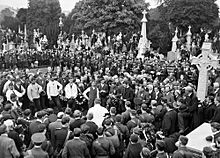
The Easter Rising, also known as the Easter Rebellion, was an armed insurrection in Ireland during Easter Week in April 1916. The Rising was launched by Irish republicans against British rule in Ireland with the aim of establishing an independent Irish Republic while the United Kingdom was fighting the First World War. It was the most significant uprising in Ireland since the rebellion of 1798 and the first armed conflict of the Irish revolutionary period. Sixteen of the Rising's leaders were executed starting in May 1916. The nature of the executions, and subsequent political developments, ultimately contributed to an increase in popular support for Irish independence.

The Irish Republican Brotherhood was a secret oath-bound fraternal organisation dedicated to the establishment of an "independent democratic republic" in Ireland between 1858 and 1924. Its counterpart in the United States of America was initially the Fenian Brotherhood, but from the 1870s it was Clan na Gael. The members of both wings of the movement are often referred to as "Fenians". The IRB played an important role in the history of Ireland, as the chief advocate of republicanism during the campaign for Ireland's independence from the United Kingdom, successor to movements such as the United Irishmen of the 1790s and the Young Irelanders of the 1840s.

Thomas James Clarke was an Irish republican and a leader of the Irish Republican Brotherhood. Clarke was arguably the person most responsible for the 1916 Easter Rising. A proponent of armed struggle against British rule in Ireland for most of his life, Clarke spent 15 years in English prisons prior to his role in the Easter Rising, and was executed by firing squad after it was defeated.

Thomas Stanislaus MacDonagh was an Irish political activist, poet, playwright, educationalist and revolutionary leader. He was one of the seven leaders of the Easter Rising of 1916, a signatory of the Proclamation of the Irish Republic and Commandant of the 2nd Battalion, Dublin Brigade of the Irish Volunteers, which fought in Jacob's biscuit factory. He was executed for his part in the Rising at the age of thirty-eight.

Thomas Patrick Ashe was a member of the Gaelic League, the Gaelic Athletic Association, the Irish Republican Brotherhood (IRB) and a founding member of the Irish Volunteers.
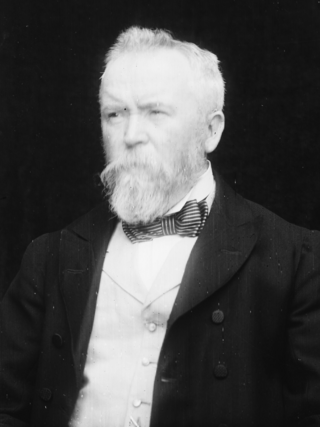
Jeremiah O'Donovan Rossa was an Irish Fenian leader and member of the Irish Republican Brotherhood.

John Devoy was an Irish republican rebel and journalist who owned and edited The Gaelic American, a New York weekly newspaper, from 1903 to 1928.
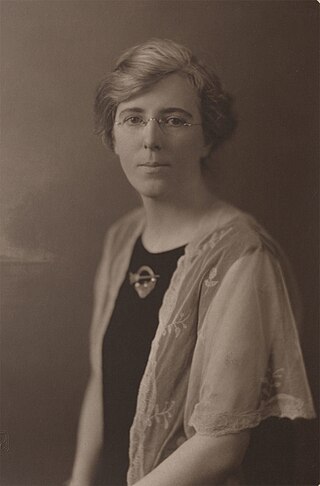
Kathleen Clarke was a founder member of Cumann na mBan, a women's paramilitary organisation formed in Ireland in 1914, and one of very few privy to the plans of the Easter Rising in 1916. She was the wife of Tom Clarke and sister of Ned Daly, both of whom were executed for their part in the Rising. She was subsequently a Teachta Dála (TD) and Senator with both Sinn Féin and Fianna Fáil, and the first female Lord Mayor of Dublin (1939–1941).
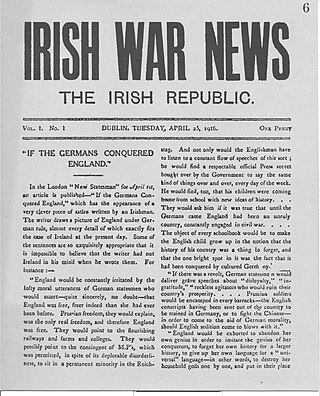
The Hibernian Rifles was a marginal Irish nationalist militia that organised in Ireland in the early years of the 20th Century, having its Dublin Headquarters at 28, North Frederick Street. Its membership were initially Roman Catholic but later opened up membership to any faith.
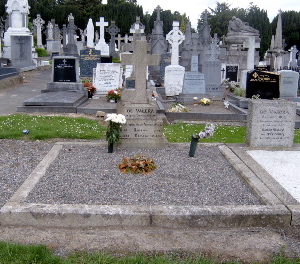
This is a list of notable people buried in Glasnevin Cemetery.
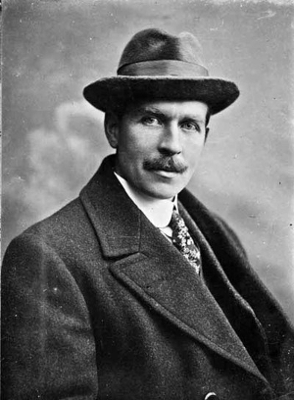
Jeremiah Christopher Lynch was an Irish revolutionary from County Cork who was a member of the Irish Republican Brotherhood and became a Sinn Féin TD in the First Dáil. A skilled organiser, he was prominent in Irish American organisations in the United States, where he spent many years.
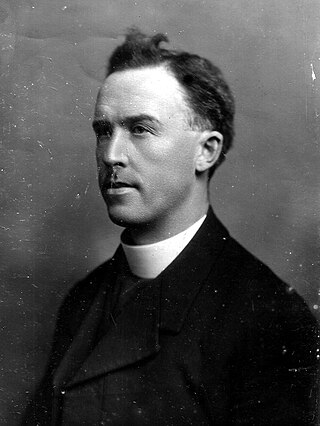
Michael O'Flanagan was a Roman Catholic priest, Irish language scholar, inventor and historian. He was a popular, socialist Irish republican; "a vice-president of the Irish Agricultural Organisation Society, he was a proponent of land redistribution." He was Gaelic League envoy to the United States from 1910 to 1912, and he supported the striking dockers in Sligo in 1913.

Richard P. Gogan was a member of the Irish Volunteers who fought in the 1916 Easter Rising. In later life, he became a Fianna Fáil politician.

Patrick Henry Pearse was an Irish teacher, barrister, poet, writer, nationalist, republican political activist and revolutionary who was one of the leaders of the Easter Rising in 1916. Following his execution along with fifteen others, Pearse came to be seen by many as the embodiment of the rebellion.

John Kenny (1847–1924) long-time member and multi-term president of the Clan-na-Gael, which supplied support to the rebels in Ireland, culminating in the Easter Rising. John Kenny was a life-long close associate of John Devoy, having been born near Devoy's hometown, been a member of the Irish Republican Brotherhood, and having worked very closely with Devoy in New York for decades. Under the cover of personal and business trips, he served as liaison between the "Home Office" and the Clan-na-Gael. In 1914 he served as the Clan's envoy to Berlin to present the Clan's proposal that Germany sell arms to the Irish, who would then stage a rebellion against their common enemy, England. On his return to New York he stopped in Dublin to inform Thomas Clarke. He returned to Ireland to deliver money for the guns and to bring back messages from the I.R.B.

Denis Dowling Mulcahy was a leading member of the Irish Republican Brotherhood and a medical doctor.

The Fenian Rising of 1867 was a rebellion against British rule in Ireland, organised by the Irish Republican Brotherhood (IRB).
Desmond Ryan (1893–1964) was an Irish writer, historian, and in his earlier life a revolutionary in Sinn Féin.
